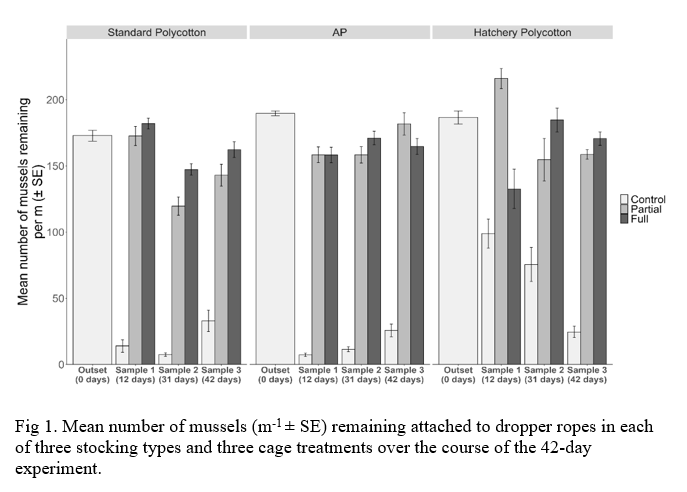EVALUATION OF THE POTENTIAL FOR ANTI-PREDATOR STOCKING TO REDUCE CROP LOSSES DUE TO FISH PREDATION IN GREENSHELL™ MUSSEL Perna canaliculus FARMS
Abstract
Enormous losses of juvenile mussels are commonplace in mussel aquaculture worldwide. Fish predation is one important contributor to these losses in many mussel growing regions. The Greenshell™ mussel industry in New Zealand is particularly susceptible to fish predation, where farmers have reported losses of seed mussels of up to 100%. The current practice for seeding juvenile Greenshell™ mussels onto coastal farms is to deploy the mussels alongside a continuous longline growing rope enclosed in a cotton stocking which holds the mussels against the rope. The mussels subsequently attach to the rope with byssus threads before the cotton degrades. During this vulnerable period, the stocking may also help to protect the juvenile mussels from fish predators whilst they are unattached to any substrate. This study investigated whether differences in the strength and weave of three types of stocking (i.e., a 54-loop weave commonly used in New Zealand, a smaller and more tightly woven stocking used in shellfish hatcheries, and a 42-loop stocking that combines two weaves of cotton together) might affect the amount of fish predation on juvenile mussels that were newly seeded onto growing rope. In an experiment, the three types of cotton stocking were each subjected to three levels of predation by restricting fish access to the growing ropes seeded with juvenile mussels by attaching full, partial and no plastic mesh cages around the ropes. The number of mussels lost from each of the treatment combinations were assessed after 10, 31, and 42 days. At 42 days on average only 15.1% (± 1.7 SE) of the seeded juvenile mussels remained on those growing ropes subjected to full fish predation, with no differences in mussel losses among three types of socking (Figure 1). In contrast, on average 90.7% (± 2.1 SE) of the seeded juvenile mussels remained on growing ropes protected from fish predation by the full mesh cages, and 87.5% (± 3.7 SE) for partial cages. For both types of protective cages there was no difference in the numbers of remaining juvenile mussels among the three types of stocking. Remote underwater video camera observations confirmed Australasian snapper (Chrysophrys auratus) were feeding on the juvenile mussels from the dropper ropes without protective cages. These results show that physical protection by cages protects juvenile mussels from fish predation, while cotton stocking, regardless of the type used, is not effective for preventing fish predation. The results also show that the majority of mussel losses in the uncaged treatment occurred in the first 10 days of the experiment, indicating that vulnerability to predation may be associated with the initial lack of byssus attachment to the growing rope. These results point to a need to develop more effective methods for mitigating the high losses of seed mussels after they are seeded onto growing ropes.
